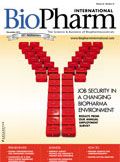Patents and Postapproval Batch Testing
Can postapproval FDA filings immunize pharma companies from patent lawsuits?
FDA requires that pharmaceutical companies create and maintain pre-approval batch records for both generic and brand drugs. In general, a company can do so without risking infringing any patents covering manufacture of a drug. Congress enacted the so-called "safe harbor" provision of the Hatch–Waxman Act in 1984 specifically allowing pharmaceutical companies to test their products prior to obtaining regulatory approval to market them (1). Under that provision:
It shall not be an act of infringement to make, use, offer to sell, or sell . . . a patented invention . . . solely for uses reasonably related to the development and submission of information under a Federal law which regulates the manufacture, use, or sale of drugs or veterinary biologic products (2).

Kevin Murphy
But what happens if the company is sued for infringement after it obtains approval from FDA? Until recently, most in the legal industry would have said that postapproval batch testing is not protected by Hatch–Waxman. As recent as 2011, in Classen Immunotherapies, Inc. v. Biogen IDEC, the Federal Circuit Court of Appeals—the final authority on most patent matters—decided that the safe harbor does not apply to "information that may be routinely reported to the FDA, long after marketing approval has been obtained" (2). Classen had accused Biogen and GlaxoSmithKline (GSK) of infringing Classen's patent relating to an immunization method (3). The patented method involved screening immunization schedules and selecting and administering the schedule that presented the lowest risk of developing certain immune-mediated chronic disorders later in life (4). As part of an FDA study, Biogen and GSK used the patented methods to provide vaccines, advise on immunization schedules, and report adverse vaccine effects to FDA (5). Biogen and GSK contended that their activity fell within the safe harbor (6). But the Federal Circuit disagreed, concluding that the provision only provides a safe harbor to expedite the development of information for regulatory approval of generic counterparts of patented products. GSK and Biogen were held not immune from Classen's suit.

Andrew Nason
But in August 2012, the same court decided in Momenta Pharmaceuticals, Inc. v. Amphastar Pharmaceuticals, Inc., (7) that the safe harbor provision indeed might immunize post-approval activities. The patent at issue in Momenta covered a method for analyzing batches of enoxaparin, a synthetic version of the blood-thinning agent heparin (8). Because of enoxaparin's unique chemical makeup, FDA requires batch analysis as a condition for the post-FDA approval sale of the drug (9). Momenta claimed that Amphastar's quality control testing of its enoxoparin batches infringed Momenta's patent; Amphastar argued that its testing fell within Hatch–Waxman's safe harbor because FDA required the testing (10). The Federal Circuit determined that § 271(e)(1) unambiguously covers any activity reasonably related to developing and submitting information under a federal law that regulates the manufacture, use, or sale of drugs regardless of whether the activity occurs pre- or postapproval (11).
The decision has major consequences for the industry. If the Hatch–Waxman Act protects post-approval batch testing, the value of patents on analytical methods, particularly covering biosimilars, may significantly decrease.
Chief Judge Rader, who authored the majority opinion in Classen, issued a lengthy and sharply worded dissent in Momenta, criticizing his fellow judges for failing to follow Classen (12). Judge Moore, who authored the majority opinion in Momenta and a dissent in Classen, saw it differently. She squared the Classen and Momenta decisions noting that, in Classen, there was no requirement that Biogen or GSK submit any data to FDA. By contrast in Momenta, FDA required analytical records for each batch of enoxoparin produced in order to maintain regulatory approval (13).
Whether one can reconcile these two decisions, the Supreme Court could very well end up resolving the issue. GSK filed a petition for certiorari asking the Supreme Court to clarify "[w]hether the Federal Circuit's interpretation of § 271(e)(1) [in Classen], which arbitrarily restricts the safe harbor to preapproval activities, is faithful to statutory text that contains no such limitation, and decisions of this Court rejecting similar efforts to impose extratextual limitations on the statute" (14). The Supreme Court may welcome the opportunity to provide its guidance on the scope of Hatch–Waxman's safe harbor—an issue the high court has addressed twice before (15)—especially in light of this seeming inconsistency in Federal Circuit precedent in this area of the law.
Kevin Murphy is a partner with the New York office of Frommer Lawrence and Haug LLP. Andrew Nason is an associate in the DC office of the same firm, KMurphy@flhlaw.com. The views expressed in this article are solely those of the authors and are not to be attributed to Frommer Lawrence and Haug LLP or any of its clients.
REFERENCES
1. Eli Lilly & Co. v. Medtronic, Inc., 496 U.S. 661, 669-71 (1990).
2. 35 U.S.C. § 271(e)(1) (2012).
3. 659 F.3d 1057, 1060, 1070 (Fed. Cir. 2011).
4. Ibid. at 1060.
5. Ibid. at 1070-72.
6. Ibid. at 1070.
7. 686 F.3d 1348 (Fed. Cir. 2012).
8. Ibid. at 1351.
9. Ibid. at 1353.
10. Ibid. at 1352-53.
11. Ibid. at 1354-55.
12. Ibid. at 1361-76.
13. Ibid. at 1357-58.
14. Petition for a Writ of Certiorari at i., GlaxoSmithKline v. Classen Immunotherapies, Inc., No. 11-1078 (U.S. Feb. 28, 2012).
15. Merck KGaA v. Integra Lifesciences I, Ltd., 545 U.S. 193, 206-07 (2005); Eli Lilly & Co. v. Medtronic, Inc., 496 U.S. 661 (1990).

VERAXA and Voyager to Create Combined Business for Advancing Pipeline of Next-Gen Cancer Therapies
April 23rd 2025The proposed business combination would create a publicly traded, clinical-stage biopharmaceutical company that will focus on developing a pipeline of next-generation cancer therapies.
Tokyo University of Science Research Team Explores Improved Delivery of Antisense Oligonucleotides
April 18th 2025Using cholesterol-modified oligonucleotides, the research team aims to improve the delivery of antisense nucleotide-based therapies for treating neurodegenerative diseases and brain cancers.